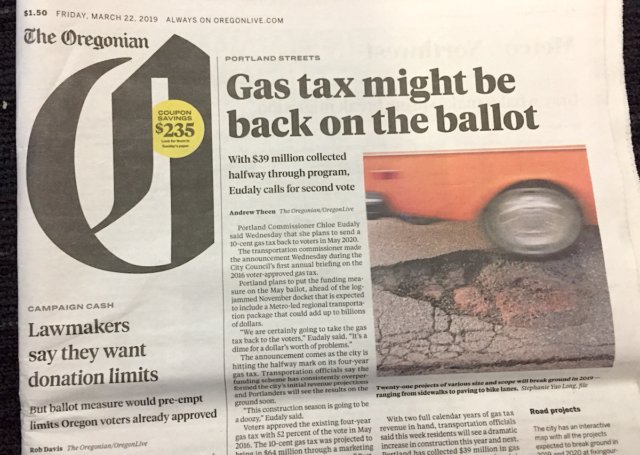

Don’t call this a travel blog, but my recent trip to Portland, Oregon, left me with a journalistic observation: Residents of the Beaver State are fortunate to have thorough coverage of their government from The Oregonian.
Known as Oregon Live online, the state’s largest publication was for sale in the newsstand of the city’s train station. After a personal day visiting Portland and former NonDoc team member Amy Stinnett, I was headed to Seattle for the wedding of NonDoc Writers’ Fund contributor and occasional content creator Sam Magid. (Congrats, pal.)
Facing a four-hour train ride, I gladly paid the $1.50 price for 56 pages of The Oregonian, which transitioned to a tabloid-size print product in 2014. Newspaper traditionalists might prefer a broadsheet style, but the 11-inch-by-15-inch format proved easy to read in the close quarters of an Amtrak train that did not have functional Wi-Fi.
A political junky who covers the Oklahoma Legislature, I was thrilled to find The Oregonian’s Friday, March 22, edition full of informative coverage of the Oregon Legislature. With our own legislative body returning from a light week, I hope you find the following recap of pending Oregon issues interesting, especially when compared and contrasted to the Sooner State.
Fuel and transportation tax proposals
Friday’s edition of The Oregonian featured numerous stories about state government and local electoral issues, an impressive daily display of watchdog coverage beyond the capacity of any single Oklahoma publication. The day’s front-page stories discussed two major political decisions.
First, Portland leaders are looking to renew a $0.10-per-gallon gas tax for roads, sidewalks and bike lanes (which already seemed bountiful to me as the resident of a city now debating the need for more cyclist-friendly infrastructure).
Portland would vote on renewing the $0.10 gas tax in May 2020 “ahead of the log-jammed November docket that is expected to include a Metro-led regional transportation package that could add up to billions of dollars,” according to the article.
Recalling Oklahoma’s recent fight to raise the statewide gas tax only $0.03, the $0.10 municipal gas tax seemed notable, especially considering another story on page A6: Business group calls proposed $2 billion tax hike ‘too much.’
Leaders of the Oregon Legislature, controlled by Democrats since 2007 (and who now hold supermajorities), want to strike an agreement on either a gross-receipts, value-added and/or corporate income tax hike as a way to pump more money into the state’s education system.
Sound familiar, Oklahoma? There are differences, however.
For starters, Oregon’s Legislature only conducts regular session once every two years, meaning they pass a two-year budget. As a result, that $2 billion figure becomes $1 billion per year, which is still a lot of money. But it’s also worth noting that the position of Oregon’s business leaders is more nuanced than simply preferring a value-added tax to a gross-receipts tax. They argue that reforms should accompany any revenue increase. Specifically, people are concerned about $26.6 billion in unfunded pension obligations.
Sound familiar, Oklahoma?
From The Oregonian’s story about the proposed $2 billion tax hike: “The state’s full pension obligations on behalf of state agencies and higher education as well as schools are projected to eclipse nearly 80 percent of the tax increase by mid-2021.”
In other words, about $1.6 billion of the proposed $2 billion in new taxes for education could never reach the classroom, instead back-filling a hole past lawmakers left unaddressed.
Oklahoma faced similar pension system issues only a decade ago, when unfunded liabilities were estimated at $16.1 billion in 2010. Financially prudent reforms devoted more dollars “off the top” to combat the issue, though retirees have gone without a cost of living adjustment for 10 years. This session, Oklahoma lawmakers are pushing a COLA for pensions.
Oregon one of five states with no campaign donation cap
Returning to the front page, readers learned more about a campaign finance reform battle in Oregon, one of only five states with no cap on individual or corporate political donations.
The Oregonian released a five-part series and database on the topic earlier this year titled Polluted By Money, and Friday’s story detailed what actions lawmakers could take on the issue, which is not new. Voters approved a minuscule cap ($500 for statewide races and $100 for legislative campaigns) in 2006, but a state Supreme Court ruling made it unenforceable.
In planning a 2020 state question, Oregon legislative leaders now want to establish a new system with a higher cap, such as $5,000. In neighboring Washington, the cap is $1,000. In Oklahoma, an individual’s campaign contributions are capped at $2,700 per appearance of a candidate on a ballot per cycle. The Oklahoma Ethics Commission voted this month to increase that number to $2,800. Political action committees are capped at $5,000 in the same manner.
Campaign finance reform advocates in Oregon say they could seek their own state question to make the 2006-approved levels enforceable, but a variety of interests believe those caps are too low.
From the article: “When the 2006 measure was on the ballot, liberal groups including the American Civil Liberties Union of Oregon, Planned Parenthood and the state’s powerful teachers union led the opposition.”
How much should legislators earn in salary?

With Oregon lawmakers debating new taxes and new limits on campaign donations, some are seeking to raise their own salaries … again.
Oregon legislators currently make $31,200 annually, plus a $149 per diem when the Legislature is in session every other year. That salary includes a 28 percent increase that took effect Feb. 1 and was tied to state employee collective bargaining negotiations.
The Oregon Senate majority leader is “proposing a measure that would raise wages by 63 percent, to more than $50,000 per year.” She believes higher salaries would broaden the pool of citizens able to serve in the Legislature, something Oklahoma lawmakers spoke to me about in November 2017 after our state’s Legislative Compensation Board cut lawmaker pay to about $34,600 amid contentious revenue negotiations.
A quantity of quality coverage
The Oregonian’s 20-page news section also featured stories Friday about Gov. Kate Brown supporting the creation of a state climate agency, as well as an overview of a Jan. 28 data breach within the state’s foster care and welfare programs.
If you count briefs about a new health department building, outcome tracking of at-risk students and a pair of teacher-student sexual misconduct cases, it’s clear that anyone reading The Oregonian regularly receives good information about the state’s civic environment.
Additionally, this week’s copy of Willamette Week contained a strong feature on a pediatrician whose 15,000 patients largely go without the measles vaccine. The alt-weekly publication also highlighted a proposal that would ban university police from carrying firearms on campus.
Sound completely unfamiliar, Oklahoma?
For an legislative junky like myself, seeing one publication provide so much daily coverage of complex negotiations in another state proved eye-opening and informative. In 2019, it’s a fantastic feeling to open a newspaper and be pleasantly surprised by the quality and quantity of coverage.




















